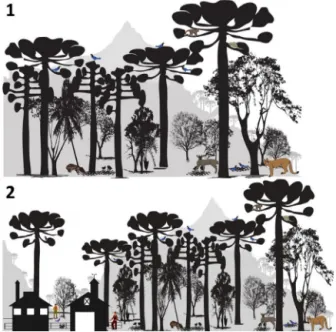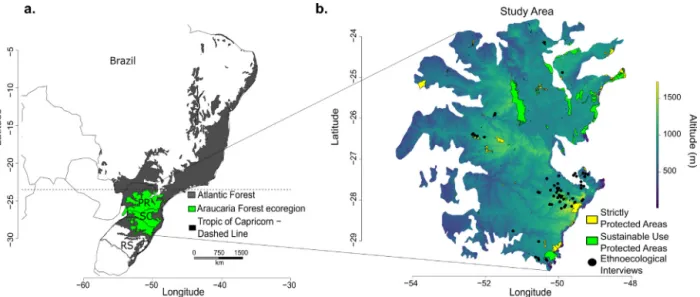HAL Id: hal-03191988
https://hal.inrae.fr/hal-03191988
Submitted on 8 Apr 2021
HAL is a multi-disciplinary open access
archive for the deposit and dissemination of
sci-entific research documents, whether they are
pub-lished or not. The documents may come from
teaching and research institutions in France or
abroad, or from public or private research centers.
L’archive ouverte pluridisciplinaire HAL, est
destinée au dépôt et à la diffusion de documents
scientifiques de niveau recherche, publiés ou non,
émanant des établissements d’enseignement et de
recherche français ou étrangers, des laboratoires
publics ou privés.
Distributed under a Creative Commons Attribution - NonCommercial - NoDerivatives| 4.0
International License
Mario Tagliari, Carolina Levis, Bernardo Flores, Graziela Blanco, Carolina
Freitas, Juliano Bogoni, Ghislain Vieilledent, Nivaldo Peroni
To cite this version:
Mario Tagliari, Carolina Levis, Bernardo Flores, Graziela Blanco, Carolina Freitas, et al..
Collab-orative management as a way to enhance Araucaria Forest resilience. Perspectives in Ecology and
Conservation, 2021, 19 (2), pp.131-142. �10.1016/j.pecon.2021.03.002�. �hal-03191988�
SupportedbyBotic´arioGroupFoundationforNatureProtection
www.perspectecolconserv.com
Essays
and
Perspectives
Collaborative
management
as
a
way
to
enhance
Araucaria
Forest
resilience
Mario
M.
Tagliari
a,b,∗,
Carolina
Levis
a,
Bernardo
M.
Flores
a,
Graziela
D.
Blanco
a,
Carolina
T.
Freitas
c,
Juliano
A.
Bogoni
a,d,e,
Ghislain
Vieilledent
b,
Nivaldo
Peroni
aaProgramadePós-graduac¸ãoemEcologia,DepartamentodeZoologiaeEcologia,UniversidadeFederaldeSantaCatarina,Florianópolis,Brazil bCIRAD,UMRAMAP,AMAP,UnivMontpellier,CIRAD,CNRS,INRAE,IRD,F-34398Montpellier,France
cDivisãodeSensoriamentoRemoto,Coordenac¸ãodeObservac¸ãodaTerra,InstitutoNacionaldePesquisasEspaciais,SãoJosédosCampos,SP,Brazil dSchoolofEnvironmentalSciences,UniversityofEastAnglia,NorwichNR47TJ,UK
eUniversidadedeSãoPaulo,EscolaSuperiordeAgricultura“LuizdeQueiroz”,LaboratóriodeEcologia,ManejoeConservac¸ãodeFaunaSilvestre(LEMaC),Piracicaba,SãoPaulo,Brazil
h
i
g
h
l
i
g
h
t
s
•Top-down restrictive measures are thebasisofAraucariaForestSystem conservation
•Bottom-up collaborative manage-ment could favor keystone plant Araucariaangustifolia
•Top-downmodelhadnegative feed-backthatdampensthesystem limit-ingitsresilience
•Bottom-upmodelhadpositive feed-backexpandingthesystemand its generalresilience
•Collaborative management could maintain the Araucaria Forests Systeminthelongterm
g
r
a
p
h
i
c
a
l
a
b
s
t
r
a
c
t
a
r
t
i
c
l
e
i
n
f
o
Articlehistory: Received7September2020 Accepted1March2021 Availableonlinexxx Keywords:AraucariaForestSystem Culturalkeystonespecies EcologicalKeystoneSpecies Ethnoecology
MixedOmbrophilousForest Participatoryconservation Resilience-thinking.
a
b
s
t
r
a
c
t
Peopleandnatureinteractsincemillenniainforestsworldwide,butcurrentmanagementstrategies addressingtheseecosystemsoftenexcludelocalpeoplefromthedecision-makingprocess.Thistop-down approachisthecornerstoneofconservationinitiatives,particularlyinhighlythreatenedandfragmented forestedecosystems.Incontrast,collaborativemanagementinvolvingtheparticipationoflocal com-munitieshasincreasinglycontributedtoconservationeffortsglobally.Hereweaskhowcollaborative managementwouldcontributetotheconservationofathreatened,culturallyimportant,andkeystone treespecies.WeaddressthisquestionintheAraucariaForestSystem1(AFS)insouthernBrazil,wherethe mainconservationstrategyhasbeentop-downbasedonrestrictiveuse.Throughouttheentire distribu-tionofAFS,weinterviewed97smallholdersabouthowtheyuseandmanageAraucariaangustifoliatrees (araucaria).WeintegratedtheirTraditionalEcologicalKnowledge2(TEK)withaliteraturereviewabout theconservationstatusofAraucariaForeststoanalyzepotentialoutcomesoftwoalternativeconservation models:top-downwithrestrictiveuse,andbottom-upwithcollaborativemanagement.Weidentified thefeedbackmechanismsineachmodel,andhowtheydampenorself-reinforcedcriticalprocessesfor AFSresilience.Ourmodelsshowedthatatop-downstrategymaintainsforestcoverresilienttoillegal loggingbutatthecostoflosingTEK(underminingsocio-ecologicalresilience)andforestresilienceto
∗ Correspondingauthor.
E-mailaddress:mario.tagliari@posgrad.ufsc.br(M.M.Tagliari).
1AraucariaForestSystem–AFS 2TraditionalEcologicalKnowledge–TEK
https://doi.org/10.1016/j.pecon.2021.03.002
2530-0644/©2021Associac¸˜aoBrasileiradeCiˆenciaEcol ´ogicaeConservac¸˜ao.PublishedbyElsevierB.V.ThisisanopenaccessarticleundertheCCBY-NC-NDlicense(http:// creativecommons.org/licenses/by-nc-nd/4.0/).
Pleasecitethisarticleas:M.M.Tagliari,C.Levis,B.M.Floresetal.CollaborativemanagementasawaytoenhanceAraucariaForest resilience,PerspectivesinEcologyandConservation,https://doi.org/10.1016/j.pecon.2021.03.002
otherexternaldisturbances,suchasclimatechange.Alternatively,abottom-upapproachbasedon suc-cessfulcollaborativemanagementschemesmayincreasethegeneralresilienceofAFS,whilepreserving TEK,thuscontributingtomaintainingtheentiresocial-ecologicalsystem.Ourfindingsindicatehowit isparamounttomaintainTEKtoconserveAFSinthelongtermthroughcollaborativemanagement.By includinglocalactorsinthegovernanceofAFS,itsresilienceisreinforced,promotingforestexpansion, maintenanceofTEK,andparticipatoryconservation.
INTRODUCTION
In the human-in-nature perspective, Social-Ecological Sys-tems(hereafterSES)aretheintegrationofhumansocietieswith ecosystemspromotingreciprocalfeedbacks,interdependence,and resilience(Folkeetal.,2010).TheresilienceofSESdependsontheir abilitytoadaptandremainwithinastabilitydomaininthefaceof disturbancesandexternalstressors,i.e.itdoesnotmovebeyond thresholdstoanalternativestateofequilibrium.Theadaptability ofSESenhancesitsresiliencebecauseitallowsthesystemtoadjust itselfinthefaceofadversities(Berkesetal.,2000).Forests world-wideareperfectexamplesofSESgiventhelong-terminteraction betweenforests,plants,andpeoples.Inthelargestconservedblock oftropicalforestintheworld–theAmazonforest,forinstance, multiplehumanmanagementpracticesovermillenniaincreased edibleplantdiversityandabundancewithinforestpatches, partic-ularlyneartoarchaeologicalsites,contributingtoenhancingfood securityandproduction(Levisetal.,2018).
One of themost emblematicSES of thesubtropical Atlantic ForestistheAraucariaForestSystem(hereafterAFS),alsoknown asAraucariaMixedForest(Fig.1).First,becauseofitsdominant species,thecandelabra-aspecttreeAraucariaangustifolia(Bertol.) Kuntze, popularly known as araucaria, has a keystone role in ecosystemfunctioning,especiallyduetoitsnut-likeseed,known as‘pinhão’,whichstructurestheassociatevertebrateassemblage spatio-temporally(Bogonietal.,2020;Oliveira-Filhoetal.,2015).
Fig.1.SchemeoftheAraucariaForestSystem(adaptedfromBogonietal.,2020).1. TheAraucariaecologicalsystem.Thearaucaria(candelabratree)andthetypical ecologicalsystemunderitscanopy,suchasOcoteasp.–“Canela”;Ilexparaguariensis –“erva-mate”;Dicksoniasellowiana–“xaxim”;andAccasellowiana– “goiabeira-serrana”;andrepresentativefauna,suchastheMazamagouazoubira –“veado campeiro”;Pumaconcolor–“cougar”;Dasyproctaazarae–“cutia”;andCyanocorax caeruleus–“azureJaybird”.2.TheAraucariasocio-ecologicalsystem.We repre-sentedthecurrentscenarioofaraucariaremnants,especiallyinsouthernBrazil, wherelocalgroups(smallholders;indigenouspeoples)continuetomanagethe systemsincepre-Columbiantimes.
Second,becauseofitsancientconnectionwithIndigenouspeoples andlocalcommunities(IPLCs;Reisetal.,2014;Robinson etal., 2018). The araucaria wasand still is widelyused by local and indigenousgroupsdue totheconsumption ofpinhão(Robinson etal.,2018),withhighcaloriccontentthathelpscopingwiththe winterseasons(MelloandPeroni,2015).Araucariaseedsarepart ofintensetraditionaluse,management,andcommerceby small-holdersas wellas pinhão extractorsacrossdifferent regions of Southernand SoutheasternBrazil(Adanetal.,2016; Melloand Peroni,2015;Reisetal.,2014;Quinteiroetal.,2019;Tagliariand Peroni,2018;Zechinietal.,2018).Thecomprehensionthat cer-tainspeciesarecrucialtomaintainingdifferentcultures,suchas smallholdersorindigenousgroups,wasthebasistocreatetheterm “CulturalKeystoneSpecies”(GaribaldiandTurner,2004).Herewe useasimilarterm“culturallyimportantspecies”,followingFreitas etal.(2020),whichconsidersthespeciesoverridingroleinpeople’s culture,althoughnotnecessarilyindispensableforthesurvivalof a specificculture. However,if a culturally important species is extinctlocallyorhassufferedapopulationdecline,itwillstrictly influencelocalpeoples’subsistenceandspirituality(Freitasetal., 2020),aswellasthetransmissionofTraditionalEcological Knowl-edge(Berkes,2009).Yet,giventheintensecommercialexploitation ofA.angustifoliaduringthe20th centuryduetoitshigh-quality
wood(WendlingandZanette,2017),thespeciesiscurrently classi-fiedas“CriticallyEndangered”accordingtotheInternationalUnion forConservationofNature(IUCN,Thomas,2013).Sincethen,the Brazilian legislation forbids anyforms of araucaria logging and stimulatesthecreationandmaintenanceoftop-downprotective strategies.Asaresult,StrictlyProtectedareasarethecornerstoneof conservationstrategiesrelatedtoAraucariaForestSystems,which oftenexcludelocalandindigenouspeoplesfromparticipatingin biodiversityconservation(Zechinietal.,2018).
ProtectedAreas(PA)arewell-known refugesforbiodiversity andecosystems,particularlyintheAtlanticForest,wheremostof thesystempersistsinfragmentssurroundedbydenselyinhabited urbanandruralareas(ScaranoandCeotto,2015;Pachecoetal., 2018;Metzgeretal.,2019).AlthoughProtectedAreasencompass only4%to6%ofthecurrentAraucariaForestextent(Castroetal., 2019;Ribeiroetal.,2009), studiesevaluatingtheireffectiveness foraraucariaconservation(Castroetal.,2019)didnottakeinto accountanothermajorcategory:LegalReserves– aspecial pri-vatePA.ThesecompulsoryprivatePAshostalmostone-thirdofall remainingnativevegetationintheAtlanticForest(Metzgeretal., 2019).MostofthenativeAraucariaForestfragmentsoccurwithin smallfarms(BittencourtandSebbenn,2009).Consequently,itis undeniablethatlocalsmallholdersalsocontributetopreserving, willinglyorunwillingly,theAraucariaForests.However,previous ethnoecologicalsurveyshavesuggestedthattop-downstrategies (i.e.maintenance andcreationofStrictlyPublicProtectedAreas andPrivateProtectedAreas)maynegativelyimpactthe interac-tionsbetweensmallholdersandaraucariatrees(Adanetal.,2016;
TagliariandPeroni,2018).Forinstance,becauseremoving arau-cariatreesisillegal,somelandownersdonotdependonaraucaria’s resources,andthusarepronetoactivelypreventaraucaria’s nat-uralregenerationbyremovingitsseedlingsfromtheirproperties beforetheyreachmaturity(Adanetal.,2016;MelloandPeroni, 2015;Quinteiroetal.,2019;TagliariandPeroni,2018).Inthiscase,
livestockfarming(e.g.cattle),pastureorcropproductionfor sub-sistence,suchascornormanioc,usuallycompetewitharaucaria’s naturalregeneration,creatingahuman-plantbarrier(Adanetal., 2016;TagliariandPeroni,2018),wheresomelandownersstatethat theylosetherightstousetheirlandsbecauseofprotectedspecies (Quinteiroetal.,2019).
The araucaria case is therefore a conservation dilemma: people and natural resources interact since millennia, but cur-rent management strategies often exclude local people from thedecision-making process.Top-down strategiespreventlocal engagement in AraucariaForest conservation. Furthermore,the contributionoftop-downconservationstrategiestothelong-term conservationofnature,individuallyorglobally,stilllacks effective-ness(RodriguesandCazalis,2020),especiallyregardingpotential limitations totheprotectedareaperse,suchassocio-ecological resilienceorclimatechangeimpacts(Ferroetal.,2014).In con-trast,bottom-upstrategies,developedtogetherwithlocalhuman groupsthroughsharingdecisionsbetweengovernments, institu-tionsandlocalresourceusersaremorelikelytoproducebenefits forthesocial-ecologicalsystemasawhole,besidesstrengthening ecosystemresilience(Folkeetal.,2010;Bennettetal.,2016).
From the human-influenced expansion of Araucaria Forests during the past two millennia (Robinson et al., 2018) to the currenthighlyproductivesystems–suchasthe“faxinais”– under-neatharaucariacanopies,combinedwithIlexparaguariensis,locally knownas“yerba-mate”,atraditionaltea-likebeverage(Reisetal., 2018),humansarepartoftheAraucariaForestSystem(Reisetal., 2014).Themaintenanceoftraditionalpracticesconstitutesa gen-erational body of knowledge, beliefs, and practices, known as TraditionalEcologicalKnowledge(TEK;sensuBerkes,2009),which is fundamental for the persistence of social-ecological systems (Folkeetal.,2005).Inpractice,localsocietiesthatmanage ecosys-temsbasedonTEKcontributetomaintainingculturallyimportant species aswell ashuman cultures resilient by a positive feed-backmechanism(Cámara-Leretetal.,2019),andbydoingso,this processalsomaintainstheecosystemresilient,particularlyif man-agementaddressesakeystonespeciessuchasaraucaria(Bogoni etal.,2020).Consequently,acrucialsteptomaintainingthe Arau-cariaForestSystemresilientisbymanagingthefeedbackswithin itssystem(Biggsetal.,2012;Musavengane,2019;andseeFig.1
comparingtheAraucariaecologicalandsocio-ecologicalsystem). Feedbacksareinteractionsinwhichtheresultingeffecteither reinforces (positive) or dampens (negative) change (DeAngelis etal.,1986),influencingecosystemdynamics.Forinstance,when treesestablishinafire-pronesavannalandscape,theyreducefire spread, favoring forest expansion(vanNes et al. 2018). Partic-ularly, thepositive feedbacks,which self-reinforcechanges, are capable of triggeringcascadingeffects that push entire ecosys-temstoalternativestates(Estesetal.,2011;Schefferetal.,2001). Feedbacksdepicttheecologicalprocessesthatpromoteordegrade ecosystemresilienceandfunctioning;andhencearethekey mech-anismstobeincorporatedinecosystemmanagement(Briskeetal., 2006).Bothpositiveandnegativefeedbacksplaymajorrolesinthe self-organizationofsocial-ecologicalsystems.Therefore,to man-ageresilienceit isnecessarytounderstandthemostimportant feedbacksinthesystem,especiallyinvulnerableandthreatened ecosystems,suchasAraucariaForests(Briskeetal.,2006)where localpeopleswithdeepecologicalknowledgearelikelytobe crit-icalpartners.
Collaborativemanagement(co-management)impliesa partic-ipatory decision-making process in which the management of a natural resource is shared between users and other actors, suchasnational,andsubnationalgovernments,Non-Governmental Organizations (NGOs), and/or local cooperatives (Berkes and Davidson-Hunt, 2006). Garibaldi and Turner (2004) argue that if local peopleidentifythemselves witha certainspecies, they
willhavea strongdesiretopreserveorrestoreit. Preservinga culturallyimportant species, therefore,may guarantee the par-ticipationof differentactors in species’ conservationprograms, andconsequentlybenefitboth thespecies,localpeople,andits surroundingecosystem (Cristancho and Vining, 2004;Garibaldi andTurner,2004;Nobleetal.,2016).Althoughstudiesaddressing co-managementschemesofculturallyimportantspeciesremain scarce in the literature due to the lack of ecological, social, andeconomicquantitativedata,thisbottom-upapproachseems promising to effectively engage local people into conservation actions(Freitasetal.,2020).Furthermore,co-managementmaybe partofresilience-thinkingbecauseitincorporatessomeofitsmain principles,accordingtoStockholmResilienceCentre(Stockholm ResilienceCentre,2013),suchasthemanagementoffeedbacksand theparticipationoflocalsinthegovernanceofthesocial-ecological system.
Applyingresilience-thinkingtolocalorregionalconservation issuesisstillagreatchallengebecausedecision-makersare usu-allyattached to traditional conservation strategies. In thecase ofAraucariaForestSystems,wherethemainconservation strat-egyisfocusedonatop-downconservationmodelwithrestrictive use,uncertaintiesstillexistwhetheracollaborativemanagement scheme could contribute to improving conservation outcomes. Herewe addressthis dilemmaina broadscalestudy toobtain detailedinformationonthestateoftheAraucariaForestSystem andunderstandhowbothtop-downandbottom-upconservation strategiesmayaffecttheresilienceofthissystem,includingits cul-turalandecologicaldimensions.First,basedonacomprehensive literaturereview,weanalyzefeedbacksandtheresulting dynam-icsoftwoalternativeconservationmodels:(1)top-downunder restrictiveuseand(2)bottom-upwithco-managementschemes. Second,based onevidence from97 semi-structured interviews withsmallholdersacrosstheAraucariaForest, weexploredthe risksandbenefitsofimplementingbothmodels.Bypresentingthe keyinteractionsandfeedbacksthatcouldstrengthenlocal engage-mentforaraucariaconservation,weexpecttoprovidea critical perspectiveformanagingandenhancingAraucariaForestSystem resilience.
METHODS
Studyarea
ThestudywasconductedinsouthernBrazil,acrosstheentire extentoftheAraucariaForestecoregion(Fig.2)andcoveringfour environments:Alluvial-onoldterracesassociatedwiththeriver system;Sub-montane-constitutingdisjunctionsataltitudesbelow 400m;Montane-locatedapproximatelybetween400and1000 mof altitude; and High Montane - comprising altitudes above 1000m(IBGE,2012).Thehighlandclimate,wheretheescarpment rises ∼1000m fromtheAtlantic Forest coastalplain,is humid mesothermic;temperature range between15-20◦C;and mean annualrainfallof 1500-2000mm (Robinson etal.,2018).Atits northeasternlimit,theecoregionexperiencesa tropicalclimate, andpersistsonlyatspecificcoldtemperaturesspotsathigher alti-tudes,suchasMantiqueirahills,attheHighRioPretoMicrobasin (Castroetal.,2019;Quinteiroetal.,2019).
Araucariapoliciesandlegislation
Severalcategoriesof protectedareas exist inBrazil: Conser-vationUnits,whicharedividedintoStrictlyProtectedAreasand SustainableUseAreas,andaremanagedbyfederal,state,or munici-paladministration,orthroughpartnershipswiththeprivatesector (DeMouraetal.,2009);PermanentPreservationAreasandLegal
Fig.2. (a)TheAtlanticForest(darkgray)withtheAraucariaForestecoregion(green)showingthethreeBrazilianstateswhichmainlyencompasstheecoregion:Paraná (PR),SantaCatarina(SC),andRioGrandedoSul(RS);(b)TheAraucariaForestaltitudemapandthedistributionofConservationUnits:Strictly(yellow)andSustainableUse ProtectedAreas(green);blackdotsrepresenttheoccurrenceof97ethnoecologicalinterviewsinthisstudy.WehighlightthatthreeinterviewsoccurredatSãoPaulostate (beyondtheAraucariaForestecoregion)atCunhamunicipality.
Reserves(privateprotectedareaswithinprivateproperties);and IndigenousLands(Pachecoetal.,2018).AccordingtotheBrazilian NationalSystemofConservationUnits(BRASIL,2000),the Sustain-ableUsecategoryisdividedintosevensub-categories,ofwhich two couldbespeciallytargetedtoTEKholdersintheAraucaria Forest System: Sustainable Development Reserves and Extrac-tiveReserves.Bothtypesofprotectedareasaimtosafeguardthe livelihoodsandculturesoftraditionalsocialgroups,aswellasto conservenatureanditsbiodiversity(DeMouraetal.,2009).Also, ExtractiveReservesrequiresomelevelofcommunityorganization andcooperation.
However,only10.6%oftheAtlanticForest(thusincludingthe AFS)isencompassedbyConservationUnits,mostlyofSustainable Use(75%).Furthermore,fromthe75%ofSustainableUse Conser-vationUnitscreatedwithintheAtlanticForest,only0.45%and0.62 %areclassifiedasSustainableDevelopmentReservesand Extrac-tiveReserves,respectively(Pachecoetal.,2018).Asaresult,few protectedareasintheAFSrecognizetheimportanceoftraditional peoples.Also,SustainableUseConservationUnitsaremanagedby thestategovernments,contrarytoStrictlyProtectedAreas– man-agedbyFederalgovernment–;andIndigenousLands,whichcover only0.72%oftheAFSarea(Pachecoetal.,2018),areadministered bytheFederalIndianAgency–FUNAI.Finally,almostone-thirdof AtlanticForest’sremainingnativevegetationoccurswithinLegal ReservesandPermanentPreservationAreas,inprivateproperties (Metzgeretal.,2019).Consequently,mostofthenativeAraucaria Forestoccurswithinsmallfarms(BittencourtandSebbenn,2009) anditisinspectedbymunicipal,state,andfederalagencies.Farmers whouseandmanagearaucaria’sresourcesareusuallylow-income smallholderswhodonotreceiveanyfinancialreturnfor conserv-ingforestedareas(OrellanaandVanclay,2018).Thelackofpolitical incentivesforAraucariaForest’sactivemanagementhasledto ille-galland-usepracticeswithinLegalReserves(OrellanaandVanclay, 2018).
TheBrazilianlegislationprohibitsanytypeofmanagementof araucaria timber(Lei daMata Atlântica or Atlantic Forest Law n◦11.428/2006;CONAMAResolutionn◦278/2001).However,the ParanáStaterecentlyapprovedanewLawn◦20.223/2020(Paraná OfficialDiary,2020),whichregulatestheplantingandexploitation ofAraucariaangustifolia,aimingtostimulatetimbermanagement programs.Thisnewlawdefinesandauthorizestimberexploitation inprivatepropertiesbeyondrestrictedareas(e.g.LegalReserves)
andareaswhereillegaldeforestationpreviouslyoccurredwithin theAtlanticForest.Yet,bypromotingonlytimberexploitation,a newmarketiscreatedforaraucaria,possiblystimulatinglocal pop-ulationsunderTEKsystemstoabandontheirancientpractices.This alternativeeconomicactivitybenefitslandownersbutmay under-minetheresilienceofthesocial-ecologicalsysteminthelong-term. Wehighlightthatlegislationshouldalsopromote,inthissense,the maintenanceofAraucariaForeststands(“FlorestaemPé”)beyond LegalReservesaspotentialareas forco-managementinitiatives viaPaymentforEnvironmentalServices(Tagliarietal.,2019). Sus-tainablepinhãoproductionandAraucariaForestreforestationare someoftheexistingprojectsunderthepossibilitiesofPaymentfor EnvironmentalServices(seeTagliarietal.,2019).
TheTraditionalEcologicalKnowledgeholdersinthecontextofthe study
Within the AFS different actors use, manage, and explore araucariaresources as opposingtoother social groups who do notusethem.DespitehumanmanagementsincePre-Columbian times,whereethnicgroupscultivatedpinhãoforsubsistenceand religiousness(Reisetal.,2014),duringthe20thcentury,a
combi-nationofagricultureexpansion,urbanization,andloggingchanged abruptlytheAFS(Rezendeetal.,2018;Ribeiroetal.,2009). Log-gingwasespeciallyrelevanttodecimate97%ofaraucariaremnant populationssincethebeginningofthe20thcentury(Enrightand
Hill,1995).Thisexploratoryscenarioculminatedinseveral restric-tivemeasures,suchasloggingprohibition,toprotectthe‘Critically Endangered’speciesfortheIUCNRedList(Thomasetal.,2013).
InAFS,manysocialgroupsuseandmanagearaucariaresources, butother social groupsdo not useormanage them. Thelatter reliesmainlyonlivestock, agriculture,and farmingsystems for commerce and subsistence, while smallholders who use Arau-cariaForestSystems dependeconomicallyonpinhãoextraction andotherassociatedcrops(e.g.,tobaccoandyerba-mate)fortheir livelihoods(Adanetal.,2016;Quinteiroetal.,2019;Tagliariand Peroni,2018).Thisinteractionbetweentraditionalsmallholders andAFSusuallysurpassesmorethanonegeneration,becausethey werebornandraisedinthesamefamily’sproperties(Adanetal., 2016),wheretheymightlearntheprocessesofcommunity orga-nizationandcooperation(Reisetal.,2018).Wethusdefinedthe specificgroupof smallholdersand pinhãoextractorsdistributed
acrossSouthernandSoutheasternBrazilasTraditionalEcological Knowledgeholdersinthecontextofthestudy.Thisattribute indi-catesknowledge,use,anddependencyonaraucariamanagement. Weproceededwiththeapplicationofthesemi-structured ques-tionnairewithTEKholders.Potentialparticipantswereindicated byinformalconversations withsmallholdersandpinhão extrac-torsineachmunicipalityandwithenvironmentalspecialists(such asmunicipalitiesorStateenvironmentsbureaus,professors,and universities).Weappliedthesnowballtechnique(Bernard,2006) to followthe semi-structuredinterviews, where participantsat theendoftheinterviewrecommendedpeopledirectlyinvolved inaraucariamanagement.Werecognizethatindigenouspeoples, such as Southern-Jê and Guarani, have shaped remnant forest composition in SouthernBrazil(Cruz etal.,2020), and arealso importantTEKholders.However,duetoethicalaspectsandlegal authorizationwedidnotincludeindigenouspeoplesinourstudy.
Datacollectionfromethnoecologicalinterviewsandtheliterature
Weconductedtwostrategiesfordatacollectionfromthestudy area:fieldworkandacomprehensiveliteraturereview.To quan-titatively assess the aspects of araucaria co-management with local smallholders and araucaria nut-like seeds extractors, we first identified key-regionsinSouthern and SoutheasternBrazil where pinhão use, commerce, and management are commonly described (e.g.regionalpinhãoparties,suchas“FestadoPinhão” at Lages and Cunha municipalities; informal pinhão commerce along estate highways; andpublishedliterature). We thus con-ducted97semi-structuredinterviewswithkey-informantsinfour Brazilian States:Paraná,SantaCatarina,Rio GrandedoSul,and São Paulo (surroundings of Mantiqueira hills at Cunha munic-ipality), covering 14 municipalities between March 2018 and January2019(Fig.2).Priortotheapplicationofthequestionnaire totheparticipants,weobtainedinterviewees’consentfollowing the codeof ethics ofthe InternationalSociety of Ethnobiology. Our study was approved by the ethics committee of the Fed-eralUniversityofSantaCatarina(CAEE:86394518.0.0000.0121). Thesemi-structuredinterviewprotocoladdressedthreemain top-ics:(i)historicalmanagementandsocioeconomicfactors;(ii)the araucariaecologyandethnoecologyaspects;(iii)interviewees’ per-spectivesaboutclimatechangethreatsforaraucaria(seeTable1
andTableS1).Toassessthelocalknowledgeandstate-of-the-artof araucariaco-managementforthisstudy,weselectedspecific open-endedquestionsthroughthequestionnairesuchas(i)“Whatisthe importanceofpinhãotoyourproperty?”;(ii)“Whatarethecauses behindtheexpansion/retractioninaraucaria’spopulation?”;(iii) “How muchpinhão (kg)hasbeengatheredinyour propertyon average?”; (iv)“How many ethnovarieties ofaraucaria canyou identifyinthelandscape?”;(v)Whatarethedifferencesinsize, color, taste,ripeningperiod oftheethnovarieties? (vi)“Doyou practiceanymanagementduringpinhãogathering?”.Finally,we compiledthisdatatoproduceatheoreticalframeworkthatcould supportpotentialcollaborativemanagementarrangements.Pilot interviewsprecededdatacollectiontorefinethesemi-structured questionnaireinJanuaryandFebruary2018.
Thecomprehensiveliteraturereviewwasperformedbyusing “WebofScience”searchengine,followingBogonietal.(2020)and
Monta ˜no-Centellasetal.(2020).Wesearchedforspecifictermsin theabstractsofarticlespublishedbetween2010and-2020: “arau-caria*”and“angustifolia*”and“conservation*”or“cultural*”.Both terms“conservation”and“cultural”weredefinedbecausetheyare commonlyemployedinscientificpublicationstargetingaraucaria conservationandethnoecologicalstudies.Wefound70scientific peer-reviewedarticles(TableS2)andincludedafewnon-indexed references,suchasPh.D.theses.First,wecross-checkedthe litera-turereviewinformationwithourfieldworkdata.Second,weused
theselectedpeer-reviewedarticlestoproposeaschematic frame-work(TableS3)basedontwoalternativeconservationmodels. Top-downversusbottom-upconservationschemesforthe AraucariaForestSystem
Tocreatethealternativeconservationmodels,wefollowedthe frameworkofcomplexadaptivesystems,whichunderstandsthat social-ecologicalsystemsaredrivenbyexternal factors,suchas policiesandclimatechange,aswellasbyinternalfeedbacks(Berkes etal.,2000;Folkeetal.,2010).Wefirstidentified‘ForestCover’as themainstatevariabledefiningtheecosystemfromthe conserva-tionandamoreholisticperspective.Statevariablesaremeantto representtheoverallstateofasystemandmayindicatethe exis-tenceofalternativestablestates(Folkeetal.2010).Wethendefined twovariablesrepresentingdriversunderatop-downconceptual framework:‘Deforestationandresourceoverexploitation’and‘Forest Protection’.Forthebottom-upconceptualframework,weuseda secondstatevariable‘TraditionalEcologicalKnowledge-TEK’,and ‘Collaborativemanagement’asadriver.Thesevariableswere pre-viouslyidentifiedasthemostimportantforAFSdynamicsinour literaturereviewandrepresentcriticalelementsineach conser-vationmodel (TableS3). For instance,oneof themaingoalsof protectedareasishaltingbiodiversityloss,suchasdeforestation (Rodrigues and Cazalis, 2020).In Brazil, both federal and state governmentsareresponsiblefortop-downconservationmodels, especiallyintheformofProtectedAreas,suchasStrictlyProtected andSustainableUseConservationUnits,orLegalReserves(Metzger etal.,2019; Pachecoet al.,2018).Incontrast,we defined‘TEK’ asanotherstatevariableunderabottom-upconservationmodel becausearaucariacanbeclassifiedasaCulturallyImportantSpecies thatdependon‘TEK’topersist(Adanetal.,2016;Quinteiroetal., 2019;Reisetal.,2014;TagliariandPeroni,2018).Bothconceptual modelssuggestthatalternativefeedbackloopsproducealternative dynamicsofAraucariaForestSystems.Followingthesetwo mod-els,weproposethemainthreats,strategies,andactorsinvolved,as wellasthebenefitsandrisksofbottom-upandtop-down conser-vationstrategies(inspiredbyFreitasetal.,2020).Finally,alsobased onthepublishedliteratureandfielddatafromthisstudythat indi-catesthebottom-upschemeasthemostpromisingformaintaining AFSinthefuture,weevaluatethepossibilitiesforimplementing collaborativemanagementsthatcontributetostrengthening envi-ronmentalgovernanceintheregion.
RESULTS
Socio-economicbenefitsandco-managementpossibilitiesfor araucariaresources
According to our interviews, local smallholders and pinhão extractorsareinvolvedintheextractionofaraucariaseeds (pin-hão),foratleast3.5generations(mean=3.8generations,where eachgenerationrepresents25yearsonaverage).Thereare fam-ilygroupswhohavebeenlivinginthesameregionfor130-150 years(35familygroupsor36%).Thislonginteractionbetweenthe participantswitharaucaria’sresourcesbringslargesocio-economic benefitstolocalfamilies.Amongthe97participants,63(65%)told thatsomehowpinhãotradeinfluencestheirmonthlyincomes,from R$1000toR$2500permonth,i.e.US$490toUS$1235atthetime, in2018(WBI,2020)or∼1to2.3Brazilianminimumwagesin2018. Furthermore,17participantsamongthose63whobenefitedfrom tradeaffirmedthatatleast50%oftheirannualgrossincomecomes frompinhãotrade.Pinhãotradeisamongthethreemainsourcesof incomefor30%ofallparticipants.Livestockandothercropswere commonlycited bysmallholdersas alternativeincome sources, togetherwithpinhãotrade,suchasbeans,corn,yerbamate,and tobacco.Theamountofpinhãogatheredperseasonbythe
partici-Table1
CollaborativemanagementofAraucariaangustifoliaanditsmainchallengesforimplementation,considering:(i)Implications;(ii)potentialbenefits:cultural, ecological,social-economic,andinstitutionalarrangements,aswellaspotentialrisks;and(iii)theliteraturereviewandinterviews’datatosustainourmodel assumptions(inspiredbyFreitasetal.,2020).Co-managementforaraucariaconsidersmostlytheuse,management,andconsumptionofitsnut-likeseed,although othermanagementsystemsexist,suchaslegaltimberproduction,reforestation,maintenanceofprivatenativeremnants,andpaymentforenvironmentalservices.We usedinformationavailableintheliteraturetocharacterizethearaucariaco-managementframework.Here,wedescribeindetailtherisksandbenefitsofthearaucaria co-management.
Araucariaangustifoliaco-management
Implications Potentialbenefits Reference
Cultural
Participants’engagement(localpeople) Increase Thisstudy(questionsA3;A3a;A7a;B2;B4;seeTableS1)
Communityinvolvement Increase Thisstudy(questionsA3a;A7a;seeTableS1);Adanetal.,
2016
Societalrecognitionandoutreach Increase Freitasetal.,2020
Strengtheningofculturalvaluesand TraditionalEcologicalKnowledge
Increase Reisetal.,2014;MelloandPeroni,2015;Adanetal.,2016; TagliariandPeroni2018
Maintenanceofaraucariaethnovarieties Increase Thisstudy(questionsB4;B5;B6;B13;B14b;B14c;B15; seeTableS1);Adanetal.,2016;TagliariandPeroni2018; Quinteiroetal.,2019
Ecological
Speciesabundance Increase Thisstudy(questionsA7;A7a;B1;B13;B13b;seeTable
S1);Sühsetal.,2018 AraucariaForestecosystemconservationand
recovery
Increasegeneralresiliencetohuman andnaturaldisturbances
Folkeetal.,2010
Ecologicalinteractions Increase Bogonietal.,2020
Nut-likeseedproduction Increase Thisstudy(questionsA3;A3a;B2;seeTableS1);Robinson
etal.,2018 Connectivitybetweenaraucaria’sremnant
populations
Maintenanceofaraucariaremnants throughdifferentProtectedAreas
Tagliarietal.,inreview
Species’geneticdiversity Increase Adanetal.,2016
Contributiontofoodsecurity Increase Thisstudy(questionsA3a;B2.B3;seeTableS1);Reisetal., 2018
Social-economic
Societalrecognitionandoutreach Increase Reisetal.,2014
Stakeholders’participation Possible Tagliarietal.,2019
Possibilityoffinancialself-sustainability Possible Tagliarietal.,2019
Incomedistributionwithinthecommunity Increase Thisstudy(questionsA3;A3a;A7a;seeTableS1)
‘Conservation-by-use’possibility Possible Reisetal.,2018
Historicalcommercialoverpressure Possible Ribeiroetal.,2009;MelloandPeroni,2015;Schneider etal.,2018
Valueforsustainablearaucariaresourcesuse Possible Tagliarietal.,2019 Opportunitiesforinstitutionalarrangements
Surveillance/enforcement Possiblyincrease Freitasetal.,2020
PaymentforEnvironmentalServicesasa compensationstrategy
Possible Tagliarietal.,2019
Mainstimulitolocalengagement Cultural/moral/ethicaspects;financial compensation
Thisstudy(questionsA3a;A7a;seeTableS1);Tagliari etal.,2019
Rulesfocusingonhabitatprotection Increase2 Seefootnote
Legalpermissiontotradethetargetspecies Thereisnolegalpermission3 Seefootnote
Co-managementwiththeconsentof environmentalagencies(suchastimber productionquotasforsmallholdersuseand management)
Possible OrellanaandVanclay,2018
Financialcompensationforsupporting araucaria’sremnantsbesidesLegalReserves andPermanentPreservationAreas
Increase Tagliarietal.,2019
Potentialrisks
Reducedinspectionofenvironmentalagencies Possible Freitasetal.,2020
Historicalcommercialoverpressure High Ribeiroetal.,2009;MelloandPeroni,2015;Schneider
etal.,2018 Currentillegalharvestpressure(i.e.
deforestationandlogging)
High Adanetal.,2016;Schneideretal.,2018;Tagliariand
Peroni2018;Quinteiroetal.,2019
1SouthernBrazilianStatescreatedtheirspecificlawsforthebeginningsofpinhãocommerce(i.e.RioGrandedoSulstartsfromApril15th;SantaCatarinaandParanáfrom
April1st).Thisdecisionperiodisduetothemaintenanceoflocalfauna,especiallytheparrots“Papagaio-charão”and“Papagaio-do-peito-roxo”(AmazonapetreiandAmazona
vinacea,respectively),besidessmallrodentsas“cutia”(Dasyproctaazarae),andmammalsas“veado”(Mazamagouazoubira;LobandVieira,2008).Oncetheextractionseason beginsnolawsregulatetheamountofpinhão(kgortonne)collectedduringtheseasonperiod.
2MataAtlânticaLawn◦11.428/2006–prohibitsnativespeciesmanagementinnaturalforests.CONAMAResolutionN◦278/2001(BRASIL,2006;CONAMA-ConselhoNacional
doMeioAmbiente,2001).
3AccordingtoBrazilianlegislation,araucarianativepopulationsareprohibitedfortimberharvestingoncethespeciesis‘CriticallyEndangered’(Thomas,2013).However,
plantedaraucariaharvestingfollowingamanagementplanregisteredandapprovedbyenvironmentalagenciesisallowed,butbureaucracyandlackofflexibilityprevent thismanagementplan(WendlingandZanette,2017).
pantswasclassifiedinthreecategories:(i)upto1000kg(40%or39 participants);(ii)from1000to10,000kg(47.5%or46participants); and(iii)above10,000kg(11.5%or11participants).Formost partic-ipants,however,theextractivismofaraucariaseedsdidnotstand inpracticeaspartofaco-managementscheme,despiteinvolving localmanagementandtrade.Onlyonesmallholderdeclaredthat thepinhãotradeinhisproprietywascertifiedbyanNGOunder a co-managementscheme.Thesameparticipantis alsogranted withone projectinvolvingPaymentfor EnvironmentalServices (PES)toconservearaucariaremnantsinareasbeyondtheLegal Reservewithinhisproperty.Fourparticipantsusetheirproperties fortourismpurposesinvolvingaraucaria(i.e.ecotourism).Among thesefourinterviewees,twoofthemhaveco-management part-nerships withinternationalstakeholders and NGOs topromote sustainabletourismintheAraucariaForestregion.
TraditionalEcologicalKnowledgeaboutaraucariamanagement andethnovarieties
Sixty-oneparticipants(63%) saidthat AraucariaForestcover aroundtheproperty(ifapplicable)expandedinthelastdecades dueto:(i)thecreationofProtectedAreas(N=33);(ii)restrictive legislation(N=18),consequentlysawmills’interdictionforusing nativeandthreatenedspecies(N=5);(iii)community participa-tioninreforestation(N=9);and(iv)increaseddispersalbylocal fauna(N=6).Theremaining35participantsinformedthat Arau-cariaForestcoverhasbeendecreasing,mainlydueto:(i)seedling suppression,knownas“roc¸adas”(N=22);or(ii)illegallogging(N= 18).Wealsofoundintervieweesdescribingnegativeimpactsfrom (iii)pesticides(N=1);(iv)severelegislation(N=1);and(v) eco-logicalcompetitionwithPinussp.(N=1).Weidentified23local namesfortypes(ethnovarieties)basedon320citationsfromall participants.Theseethnovarietiesweredescribedbylocalpeople (i.e.smallholdersand/orpinhãoextractors)accordingtothe ripen-ingperiodsofpinhãoseedsproducedbyfemalearaucarias.Thefive most-cited localvarietieswere: (i)“Macaco”(N=81 citations); (ii)“Cajuvá”(N=80citations);(iii)“Comum”(N=48 citations); (iv)“DoCedo”(N=31 citations);and(v)“25deMarc¸o”(N=16 citations).Mostparticipantscitedthreeethnovarieties(52.5%)and ∼25%ofthemmentionedfourdifferentethnovarieties. Ethnovari-etiesdescribedbytheparticipantsweresaidtodevelopindifferent momentsduringtheyearindicatingpinhãoproductionthroughout theentireyear.
Socio-ecologicalbenefitsandrisksofbothalternativemodelsfor AraucariaForestSystems
Thebenefitsandrisksofadoptinga top-downorbottom-up strategy for Araucaria Forest System involve different ecologi-cal, social, economic, and culturaldimensions according tothe interviewsandtheliteraturereview(Fig.3; Table1).Top-down conservationmodelspromotebenefitstowardsthetargetspecies (inthiscasearaucaria)anditssurroundingfaunaandflora;the bio-diversitymaintenance;andprovidesecosystemservices,suchas provisioning(foodwithpinhãoproduction);support(pollination; nutrient cycling); regulation (carbon sequestration; alternative foodresourceforAraucariaForestfauna);andcultural(heritage value,regionalsymbols,ecotourism).Biodiversityandecosystem servicesmaybeindirectlyenhancedbythismodel,thusfavoring humanwell-being.However,restrictivetop-downmodels(such asStrictlyProtectedareasorexcessiverestrictivelegislation)may create:(i)barriersbetweenhumangroupsandthetarget preser-vationpriority;(ii)thelossofTEKandsocio-ecologicalresilience; (iii)fragilitytoexternalstressors,suchasclimatechange.
Themostpromisingbenefitsofbottom-upco-managementare: (i)sustainablepinhãotrade;(ii)sustainabletourism;(iii)Payment
forEnvironmentalServicesprograms;(iv)potentialconservationof AraucariaForestremnantswithinruralproperties;and(v) possi-blerecoveryandexpansionofAraucariaForests.Byincorporating theseinitiativeswithlocalpeople,theymayalsostimulatelocal engagementinsurveillance,conservation,andmaintenanceof bio-diversity.Thesebenefitsareinterconnectedbetweenlocalgroups andAraucariaForest,enhancingthelong-termresilienceand con-servationof theAraucaria ForestSystem.The risksof adopting bottom-upco-managementschemesforAraucariaForestSystems mayberelatedto:(i)psychologicalbarriersbetweenlocalpeople andenvironmentalagenciesduetothememoryofhistorical exces-siveenforcement–anexampleisapracticeknownas‘roc¸adas’, whichconsistsintheremovalofaraucariajuvenilestoavoidfuture legalrestrictionsonlanduse(Adanetal.,2016)–;(ii)thepotential overexploitationofaraucariaresourceswithinprivateareas,such asillegalcutting,timberexploitation,anddeforestation(Orellana andVanclay,2018);and(iii)possiblepoorcommunicationbetween localpeople, stakeholders, and environmentalagencies (Freitas etal.,2020).However,negativeco-managementexperiencesare morelikelytobecorrectedbypositiveinnovationsfromlocal peo-ples,sincetheirTEKandtheintrinsicbodyofknowledgethrough generations might allow them tomaintain feedbacks stronger, respondingfastertoexternalchanges,enhancingadaptability,and transformabilityofthesystem(asshownbyBerkesetal.,2000).
TwoalternativemodelsofAraucariaForestconservation: top-downwithrestrictiveuse,andbottom-upwith co-managementschemes
TwoalternativeconservationmodelsofAraucariaSESshowed different feedbacks and dynamics (Fig. 4; Table S3). The top-downrestrictiveschemecontributedtoincreasingforestresilience tohumandisturbances.Thishappensbecause‘deforestation’and ‘resource overexploitation’ lead to more enforcement and ‘forest protection’(restrictive measures) by managerstomaintain ‘for-est cover’. With more forest cover, resource overexploitation is expected to decrease, relative to the overall forest abundance, reducing theperceptions of overexploitationby managers, and leadingtolessrestrictivemeasures.Inthissense,weidentifiedthat restrictivemeasuresarecreatedasaresponsetohuman distur-bances(i.e.deforestationorresourceoverexploitation),resultingin anegativefeedbackloopthatdampensforestloss(seeFig.4)and partlymaintainstheconservationpurpose.Thetop-downscheme, however,mightnotguaranteeresiliencefortheentiresystemto othertypesofdisturbances,suchasextremeweathereventsdue toclimatechange,mainlybecausethelossoftraditional manage-mentmayreducethefunctionaldiversityofaraucariapopulations (Table1;Adanetal.,2016),andconsequentlytheforests’ adap-tivecapacity in the face of unexpectedevents (Elmqvist et al., 2003).Hence,thetop-downschemecompletelydisruptsthe his-toricalhuman-plantinteractionoftheAFSthatmadethissystem resilient for millennia. In contrast, thebottom-up conservation schemeshoweda distinctfeedback loop(Fig.4).Inthis case, a self-reinforcing(positive)feedbackloopemerged inthesystem, because‘TraditionalEcologicalKnowledge (TEK)’provides oppor-tunitiesfor‘collaborativemanagement’,whichallows‘forestcover’ topersistand potentially expand.With more forestcover, TEK is expectedtoexpand as well,promoting co-managementthat enhancesthegeneralecologicalresilienceoftheforest(toallsorts ofunexpecteddisturbances),becauselocalmanagementenhances thefunctionaldiversityof araucariapopulations(Table1;Adan etal.,2016).Thepositivefeedbackloopweidentifiedhastherefore thepotentialtostrengthentheecologicalresilienceofthewhole AraucariaSESandtopromotethesystem’sexpansionbeyondits currentlimits.
Fig.3.Flowchartofbenefitsandrisks(inspiredbyFreitasetal.,2020)ofdistinctconservationstrategies.Arrowsrepresenttheexpectedoutcomesofeverystepinthe flowcharts.1.Top-downstrategiesforAraucariaangustifolia(araucaria)preservation.Asthemainconservationstrategy,top-downpolicies,suchasthemaintenance orcreationofStrictlyProtected,neglectthehistoricalhuman-plantinteractionintheAraucariaForestSystem.Thesepolicies(1)maintaintheecologicalresilienceofthe forestecosystemandprovideecosystemservices(indirectbenefitsforhumangroups),but(2)mayfailduetobarriersupontraditionalpeoplewhouse,manage,and promotethesocio-ecologicalresilienceofthesystem,leadingtothelossofTEK;increasesinoverexploitationanddeforestationpressures;andreducedresiliencetoexternal stressors,suchasclimatechange,pathogens,andinvasivespecies.2.Bottom-upconservationinitiativesforaraucariaasaCulturalImportantSpecies(CIS)under co-management.Becausearaucariaisaculturallyimportantspeciesforlocalpeople,(1)theywilllikelyfeelstimulatedtoengageinco-managementinitiativesfocusingonthis species;(2)weshouldconsequentlyexpecthighcomplianceandlocalsurveillancelocalpeople;(3)thishuman-plantinteractionwhichwilllikelyfavortheconservation ofaraucariapopulationsand(4)benefitotherspeciesco-existingintheAraucariaForest,andtheecosystemasawhole.Therearebothbenefitsandrisksthatcouldbe expectedfromthisco-managementapproach.Therisks(5)ofthisinitiativemayberelatedtothepotentialfragilearrangementbetweenlocalpeopleandinstitutions (e.g.environmentalagencies,Non-GovernmentalOrganizations,privatesectorand/orstakeholders);inadequatesurveillanceoftheco-managementinitiative;and/orthe excessiveinstitutionalenforcement.Anotherriskistheincreaseofillegalcutting(i.e.resources’overexploitation,juveniles’suppression,and/ornon-sustainabletimber production).Suchnegativeconsequences(6)willpossiblyaffectecological(i.e.ecosystemdegradation),economic(i.e.lesspinhãotrade,lossofpaymentsorcompensations forenvironmentalservices;lessecotourism),andcultural(detachmentfromlocalpeople,lossoftraditionalknowledge)aspects.Apotentialwaytocircumventthoseproblems (e.g.increaseddeforestation)couldbe(7)alternativeco-managementinitiativestargetingforestrecoveryorrecuperationofdegradedareas(dashedarrow).Thepositive scenario(8),however,couldbringecological(maintenanceoftheecosystem);economic(viaPaymentforEnvironmentalServices,sustainablepinhãotrade,ecotourism);social andculturalbenefits(i.e.localengagement;maintenanceoftheTraditionalEcologicalKnowledgeofaraucariaanditsethnovarieties,andaraucariaresources’management). Allofthesepositiveconsequencesareinterconnected(9)andcouldfinallyallowamoreresilientandcyclicalstablestate(10)oftheentireeco-socio-economicsystemof AraucariaForests,besidesactingasanalternativetothemainstreamconservationstrategy(i.e.themaintenanceofexclusionaryProtectedAreasviatop-downpolicies).
Fig.4. Theschematictop-downandbottom-upconservationmodelsofAraucaria Forestsystemsareself-organizedincontrastingways,withdifferentfeedbacks. Solidlinesrepresentpositive/negativeeffects.Cycleschemes(grayshaded) rep-resent thefeedback loop,itsdirection (i.e.counter-clockwise) andits result: negative/buffereffectorpositive/self-reinforcingstate.1.Schematic representa-tionoftheinteractionsinvolvedintop-downpolicies,suchasStrictlyProtected Areas.Thisschemeimprovesonlyaportionofthetargetecosystem,neglecting potentialsocio-ecologicalinteractions(i.e.localpeople).Thisclassical conserva-tionistapproachcreatesabufferfeedback,i.e.itsustainsthecurrentstate.Excessive resourceexploitationordeforestationgeneratesprotectivemeasuresthatbenefit forestcover.However,aforestprotectedbytop-downmeasuresmaynotcompletely avoidthesedisturbances(e.g.deforestationandoverexploitation)andmightnot contributetootherexternalstressors,suchasclimatechange.Theyalsoreducethe benefitsforlocalpeoples,whoarevirtuallyexcludedfromthesystem.2.Schematic representationoftheinteractionsproducedbybottom-uppolicies. Indepen-dentlyfromrestrictivemeasures,thisschematicsocio-ecologicalsystemindicates anincreaseinthesystem’sresilience,duetoaself-reinforcingmechanismthat pro-motesaraucariaforestexpansion.Hence,byincorporatingTEKandco-management initiatives,thisschemeincreasesthegeneralresilienceofthesocial-ecological sys-tem.Note:ourconceptualmodelisnotmutuallyexclusive,bothtop-downand bottom-upstrategiesco-occurwithinAFSandcontributetomaintainingnative forestremnants.
DISCUSSION
OurfindingsrevealthatAraucariaForestSystemsinsouthern SouthAmericamightbelosingresilienceduetoalong-term top-downrestrictivemanagementschemethatmakesthesystemless adapted toall sortsof disturbances. Partly becausethis social-ecologicalsystemdependsonTEK,whichiscurrentlybeinglost as restrictive measuresdisrupt anancient human-nature inter-action.However,ourstudyrevealsanalternativeperspectiveon howtomaintainthegeneralresilienceofAraucariaForestSystems bystimulatingTEKproduction throughacollaborative manage-ment scheme.Wehave shownthat bottom-upco-management mayself-reinforceandbenefittheresilienceofaraucariaforestsand thusprovideapossiblesolutionfortheconservationdilemmathat hasbeenthreateningthisecosystem.Co-managementinitiatives mayeffectivelyincorporatetheprinciplesofresilience-thinking: management of feedbacks;maintenance of ecologicaldiversity; and broad participation of different actors (Folke et al., 2005,
2010).Strengtheninglocalactorsandtheirrolesingovernanceis
particularlyeffectivewhencomparedtorestrictiveand exclusion-aryconservationstrategies,suchasStrictlyProtectedAreaswith excessivetop-downenforcement.Webelieveourfindingsofferan opportunitytogenerateoptimisticbottom-uppathwaystowards anefficient,inclusive,andwell-articulatedconservationstrategy thatcouldself-reinforcestheresilienceoftheAraucariaForest Sys-tem.Byshiftingfromatop-downtoabottom-upco-management schemethatincludeslocalactorstogetherwithexistinginstitutions inthegovernanceprocess,theAFScoulddeveloptransformability andadaptability,furtherenhancingitssocial-ecologicalresilience (seeFolkeetal.,2005,2010;Biggsetal.,2012;Bennetetal.,2016). Becausesimilarecosystemswithculturallyimportantplantspecies arealsoundergoingthesameconservationdilemma,webelieve thatourfindingscouldbeusefulinothercontexts.Such innova-tiveandcollaborativesystemscouldpotentiallydeveloptobecome anotherglobalbrightspotexample,wherethenaturalandcultural capitalsarepreservedbybottom-uparrangements,inspiring soci-etiesworldwide(Bennettetal.,2016).
Althoughthetop-downstrategyhasprovenusefultomaintain araucaria forestsresilient to logging and other human degrad-ingactivitiesviaa negativefeedbackloop(Fig.4), this strategy hasnotbeensufficienttomaintaintheentiresysteminthelong run.Sincethehistoricalloggingoverexploitationinthe19th
cen-tury,andlater,theinclusionofaraucariaas“CriticallyEndangered” byIUCN(Thomasetal.,2013),thecreation/maintenanceof top-downProtectedAreasbecamethecornerstoneofitsconservation (Zechinietal.2018).ProtectedAreasaimtocurbanthropogenic disturbancesinnaturalecosystemsandhaltthelossofbiodiversity (Geldmannetal.,2019;Wiensetal.,2011),butmightfailtoprevent theextinctionofseveralspeciesinthelong-termduetoclimate change(Ferroetal.,2014),aswelltoanthropogenicdisturbances (e.g.,invasivespecies;poaching;landuse;lossofgeneticdiversity;
Laurance,2013);andtopotentiallypromotesocio-economic bene-fits(givenpoorgovernanceorregionalconflicts;Lauranceetal., 2012).Insouthern Brazil,traditionallandmanagement systems protectthegeneticdiversityofaraucariapopulations,thus con-tributingtothespeciesconservationandthesafeguardingofthe SES(Reisetal.,2014;MelloandPeroni,2015;Adanetal.,2016;
Zechinietal.,2018).Asaresult,top-downconservationstrategies areinsufficienttoconserveaculturallandscape(MelloandPeroni, 2015)becauseitreducesthesystems’adaptivecapacity,aswellas theparticipationofdifferentactorsinenvironmentalgovernance; allrequisitesforsocial-ecologicalresilience(Folkeetal.,2010;de Vosetal.,2016;Musavengane,2019).
Thefeedbackdynamicsofabottom-upco-management strat-egyhasthepotentialtoenhancethesystemic resilienceofAFS aswellasother Social-EcologicalSystems,becauseit promotes adaptability through TEK production (Berkes et al., 2000), and becauseitrecognizesthattransformabilityintoparticipatory gov-ernance is necessary, as human-nature has shaped Araucaria Forest landscapes over millennia (Reiset al., 2014).Moreover, itenhancesconnectivity,becausedifferentactorsareconnected in the system (e.g. NGOs; stakeholders; local groups; govern-ments).Also,itretainsfunctionalredundancy,i.e.ifoneactoris removedfromthesystemthesystemitselfremains resilientto thedisturbancebecauseofthe differentplayerswiththesame functions.We alsofoundsupportforthenotionthata bottom-upco-managementstrategycanenhancetheresilienceofAFSnot onlytohumandisturbancesbutalsotodifferentkindsofthreats, suchasextremeweatherevents(Folkeetal.,2010).Onereasonis thatco-managementincreasesthefunctionaldiversityofaraucaria treepopulations,especially due touseand management (Adan etal.,2016;TagliariandPeroni,2018;Quinteiroetal.,2019),and consequentlytheadaptive capacity oftheforest tounexpected disturbances(Elmqvistetal.,2003).Asaresult,co-management generatesapositivefeedbackloopthatstrengthensforestresilience
aswellassocioculturalresilience.TheAraucariaForestisan exam-pleofa self-reinforcingsystem,where inthepasthuman-plant interaction wasresponsiblefor theforestexpansionbeyondits climaticniche(Robinsonetal.,2018).
Sühs etal.(2018)showedthatthemaintenance ofaraucaria maturetreestogetherwithtraditionallandmanagementpromotes Araucaria Forest expansion, saplingspecies richness and abun-dance,togetherwiththepreservation ofgrasslandsinsouthern Brazil.Theauthorsarguethatamaximalregionaldiversityofthe plant communitiescan beachieved bya balancebetween pre-servedforest areasandtraditional managementpractices (Sühs etal.,2018).Reisetal.(2018)alsoshowedthatmanagement sys-temswithintheAraucariaForest,suchasthe“caívas”and“faxinais”, maintainlandscapeswithproductiveforestfragments,thus favor-ingaraucaria conservationandhumanwell-being.Furthermore, thissystemhighlydependsontheculturalandeconomic valua-tionofpinhão(Reisetal.,2018).Theopportunitytoincreaseprofits fromaraucariaremnantscouldassurethelong-term sustainabil-ityofco-managementinitiatives(PomeroyandBerkes,1997).The broaderparticipationofdifferentactorsinenvironmental gover-nanceiswithinthebasisofco-managementinitiatives(seeFreitas etal.,2020).Hence,co-managementinitiativestargetingthe Arau-cariaangustifoliacanrepresentavaluablesolutionfortheongoing conservationdilemma.
CONCLUSION
Re-evaluatingthearaucariaconservationdilemma
Ourbottom-upconceptualmodelwasdirectlylinkedtoa spe-cific socialgroup:thesmallholdersalongtheAFS,whopossibly encompassthemajorityofAFSnativeremnantsundertheirLegal Reservesprotectedareas(BittencourtandSebbenn,2009;Metzger etal.,2019).Othersocialgroupsstillinfluenceandmanagethis sys-tem,suchasindigenouspeoples,whowereco-responsibleforthe transformationandexpansionofthesysteminthepast(Robinson et al., 2018), and remain as essential partners for developing a co-management scheme. Although we could not incorporate indigenous peoples inouranalysis,theyalsoapplytoour con-ceptualmodelasmajorTEKholders.Itisimportanttorecognize that theAFSis alsocomposedof amosaic oflandowners, agri-culturalenterprises,timberandcellulosecompanies,wherenative remnantsarestillprotectedbytop-downmanagement,suchasin StrictlyProtectionConservationUnitsandLegalReserves. There-fore,ourconceptualmodelsarenotmutuallyexclusive,andboth top-downandbottom-upstrategiesmayco-occurwithinAFSand contributetomaintainingnativeforestremnantsresilientinthe faceofglobalchanges.
AraucariaForestSystemsareaheritage,leftbypastindigenous societiesthatoncelivedintheregion(Reisetal.,2014;Robinson et al.,2018),and thatnow representsa valuable assetfor local humanpopulations (Melloand Peroni,2015;Adanetal., 2016;
TagliariandPeroni,2018;Quinteiroetal.,2019).Ourfindings indi-catethatthisheritagemightbeatriskinthelong-termforfuture generations.Thecollaborativemanagementstrategybetweenlocal peoples and otherinstitutionsinterestedin theconservation of theseancientandendemicforestsisnecessaryasanalternative strategytomaintainthissocio-ecologicalsystem.However,legal aspectsmayremovelocalpeoplefromdecision-makingand poten-tiallyproduceantagonisticactionsduetorestrictiveconservation measures,suchasseedlingsuppression(Adanetal.,2016;Tagliari andPeroni2018;Quinteiroetal.,2019)ortimberillegal exploita-tion(Schneideretal.,2018).Thisproblematicmayengenderwhat isknownasthe‘EnvironmentalPsychologicBarrier’,wherelocal peopletend toavoid effectiveactiontoimprove/conserve their
surroundingenvironment,eveniftheyperceivethattheseactions bringbiodiversitylossesandnegativeimpactstotheirlives,such aslossoflifequalityandfoodsecurity(TamandChan,2017).Still, otherco-managementinitiativesofculturallyimportantspeciesin Brazilshowedpositiveoutcomesbymaintainingtheplant-human interaction,suchasthoseinvolvingHeveabrasiliensisand Berthol-letiaexcelsa(“rubbertree”and“Brazilnuttree”,respectively)inthe BrazilianAmazon,andRumohraadiantiformis(“samambaia-preta”) in southern Brazil (De Souzaet al., 2006; Gomes et al., 2018). Co-managementprogramswiththesespecieslargelycontributed tomaintainingtheeconomiclivelihoodsandTraditional Ecolog-icalKnowledgeoflocalsmallholdersandpeoplefromindigenous andlocalcommunities(e.g.indigenouspeople,“ribeirinhos”,and/or “caic¸aras”;De Souzaetal.,2006;Gomes etal.,2018).Similarly, theconservationoftheAraucariaForestSystemdependson main-tainingTEKandpromotingcollaborativemanagementinitiatives, becausebottom-upconservationstrategiesaremorelikelyto pro-ducethetransformationsthatthesystemneedstopersistinthe uncertainfuture.Byincorporatingallactorsofthissocio-ecological system,resilienceisreinforcedtowardsexpansion,maintenanceof TEK,andparticipatorysystemicsocio-ecologicalconservation.
CONFLICTOFINTEREST
Theauthorsdeclarenoconflictofinterest.
AUTHOR’SCONTRIBUTION
MMTconceivedthemainidea,draftedthemanuscript,analyzed interviews’data,anddidthemainliteraturereview.GDBdrafted themanuscriptanddidtheliteraturereview.CLcontributedtothe literaturereviewanddevelopedthemainstructureofthearticle. BFbroughtvaluableinsightsthattransformedthepurposeofthis study.CFreviewedtheearlyversions,suggestedmainchangesin thestructureofthemanuscript.JBcontributedtothedraft evalua-tion,improvedtheinterviewquestions,andanalyzedthedata.GV contributedwiththeearlyversionsofthemanuscriptandinsights aboutpotentialknowledge-gaps.NPcontributedtodraft develop-ment,literaturereview,insightsaboutknowledge-gaps,improved theinterviewquestions,reviewedtheearlyversions,andproject financing.Allauthorscontributedcriticallytothedraftsandgave finalapprovalforpublication.
DATAAVAILABILITYSTATEMENT
ThismanuscriptispartofanongoingPh.D.thesis.The infor-mationgatheredintheethnoecologicalsurveyswillnotbeableto shareuntilthepublicationofanotherspecificchapter.However, asamanuscriptbasedontheliteraturereview(alreadypublished elsewhere)andcomplementedwiththeethnoecological informa-tionusedinthequestionnaire(seedetailsinSupplementaryFile TablesS1,S2,S3),thereadersmayfindthecoreinformationused inthismanuscript.
ACKNOWLEDGMENTS
MMTthanksalllocalpeopleinterviewed between2018and 2019 who contributed with their knowledge about araucaria, theculturallandscape, and thechallenges smallholders face in Brazil. The authors would like to thank the Coordenac¸ão de Aperfeic¸oamento de Pessoal de Nível Superior (CAPES/Brazil; Finance Code 001) for the Ph.D. scholarship for MMT and GDB. CL thanks CAPES for the post-doctoral fellowship (no
88887.474568/2020).NPthanksCNPqfortheproductivity scholar-ship(Process310443/2015-6).CTFthankstheFundac¸ãodeAmparo
àPesquisadoEstadodeSãoPaulo(FAPESP)forthepost-doctoral fellowship (Process no 2019/15550-2). JAB is supported by the SãoPauloResearchFoundation(FAPESP)postdoctoralfellowship grants2018-05970-1and2019-11901-5.Thisstudyisdedicatedto EstelamarisandPatrick.
AppendixA. Supplementarydata
Supplementary material related to this article can be found, in the online version, at doi:https://doi.org/10.1016/ j.pecon.2021.03.002.
References
Adan,N.,Atchison,J.,Reis,M.S.,Peroni,N.,2016.LocalKnowledge,Useand ManagementofEthnovarietiesofAraucariaangustifolia(Bert.)Ktze.inthe PlateauofSantaCatarina,Brazil.Econ.Bot.70,353–364,
http://dx.doi.org/10.1007/s12231-016-9361-z.
Bennett,E.M.,Solan,M.,Biggs,R.,McPhearson,T.,Norström,A.V.,Olsson,P., Pereira,L.,Peterson,G.D.,Raudsepp-Hearne,C.,Biermann,F.,Carpenter,S.R., Ellis,E.C.,Hichert,T.,Galaz,V.,Lahsen,M.,Milkoreit,M.,MartinLópez,B., Nicholas,K.A.,Preiser,R.,Vince,G.,Vervoort,J.M.,Xu,J.,2016.Brightspots: seedsofagoodAnthropocene.Front.Ecol.Environ.14,441–448, http://dx.doi.org/10.1002/fee.1309.
Berkes,F.,2009.Evolutionofco-management:Roleofknowledgegeneration, bridgingorganizationsandsociallearning.J.Environ.Manage.90,1692–1702, http://dx.doi.org/10.1016/j.jenvman.2008.12.001.
Berkes,F.,Davidson-Hunt,I.J.,2006.Biodiversity,traditionalmanagementsystems, andculturallandscapes:ExamplesfromtheborealforestofCanada.Int.Soc. Sci.J.58,35–47,http://dx.doi.org/10.1111/j.1468-2451.2006.00605.x. Berkes,F.,Colding,J.,Folke,C.,2000.RediscoveryofTraditionalEcological
KnowledgeasAdaptiveManagement.Ecol.Appl.10,1251–1262. Bernard,H.R.,2006.ResearchMethodsinAnthropology:Qualitativeand
QuantitativeApproaches.Library., http://dx.doi.org/10.1525/aa.2000.102.1.183.
Biggs,R.,Schlüter,M.,Biggs,D.,Bohensky,E.L.,Burnsilver,S.,Cundill,G.,Dakos,V., Daw,T.M.,Evans,L.S.,Kotschy,K.,Leitch,A.M.,Meek,C.,Quinlan,A., Raudsepp-Hearne,C.,Robards,M.D.,Schoon,M.L.,Schultz,L.,West,P.C.,2012. Towardprinciplesforenhancingtheresilienceofecosystemservices.Annu. Rev.Environ.Resour.37,421–448,
http://dx.doi.org/10.1146/annurev-environ-051211-123836.
Bittencourt,J.V.M.,Sebbenn,A.M.,2009.Geneticeffectsofforestfragmentationin high-densityAraucariaangustifoliapopulationsinSouthernBrazil.TreeGenet. Genomes5,573–582,http://dx.doi.org/10.1007/s11295-009-0210-4. Bogoni,J.A.,Muniz-Tagliari,M.,Peroni,N.,Peres,C.A.,2020.Testingthekeystone
plantresourceroleofaflagshipsubtropicaltreespecies(Araucariaangustifolia) intheBrazilianAtlanticForest.Ecol.Indic.118,106778,
http://dx.doi.org/10.1016/j.ecolind.2020.106778.
BRASIL,2006.Leino11.428,de22dedezembrode2006.Dispõesobreautilizac¸ão eprotec¸ãodavegetac¸ãonativadoBiomaMataAtlântica,edáoutras providências.RepúblicaFederativadoBrasil,Brasília.
BRASIL,2000.Leino9.985,de18dejulhode2000.InstituioSistemaNacionalde UnidadesdeConservac¸ãodanatureza,edáoutrasprovidências.República FederativadoBrasil,Brasília.
Briske,D.D.,Fuhlendorf,S.D.,Smeins,F.E.,2006.Aunifiedframeworkfor assessmentandapplicationofecologicalthresholds.Rangel.Ecol.Manag.59, 225–236,http://dx.doi.org/10.2111/05-115R.1.
Cámara-Leret,R.,Fortuna,M.A.,Bascompte,J.,2019.Indigenousknowledge networksinthefaceofglobalchange.Proc.Natl.Acad.Sci.116(20), 9913–9918.
Castro,M.B.,Barbosa,A.C.M.C.,Pompeu,P.V.,Eisenlohr,P.V.,deAssisPereira,G., Apgaua,D.M.G.,Pires-Oliveira,J.C.,Barbosa,J.P.R.A.D.,Fontes,M.A.L.,dos Santos,R.M.,Tng,D.Y.P.,2019.WilltheemblematicsouthernconiferAraucaria angustifoliasurvivetoclimatechangeinBrazil?Biodivers.Conserv.29, 591–607,http://dx.doi.org/10.1007/s10531-019-01900-x.
Cristancho,S.,Vining,J.,2004.CulturallyDefinedKeystoneSpecies.Hum.Ecol.Rev. 11,153–164.
CONAMA–ConselhoNacionaldoMeioAmbiente,2001.Resoluc¸ãono278,de24de maiode2001.Dispõesobreocorteeaexplorac¸ãodeespéciesameac¸adasde extinc¸ãodafloradaMataAtlântica.Brasília:DOUde18/07/2001.
Cruz,A.P.,Giehl,E.L.H.,Levis,C.,Machado,J.S.,Bueno,L.,Peroni,N.,2020. Pre-colonialAmerindianlegaciesinforestcompositionofsouthernBrazil.PLoS One15,1–18,http://dx.doi.org/10.1371/journal.pone.0235819.
DeAngelis,D.L.,Post,W.M.,Travis,C.C.,1986.PositiveFeedbackinNatural Systems.Springer-Verlag,BerlinHeidelberg.
DeMoura,R.L.,Minte-Vera,C.V.,Curado,I.B.,Francini-Filho,R.B.,Rodrigues, H.D.C.L.,Dutra,G.F.,Alves,D.C.,Souto,F.J.B.,2009.ChallengesandProspectsof FisheriesCo-ManagementunderaMarineExtractiveReserveFrameworkin NortheasternBrazil.Coast.Manag.37,617–632,
http://dx.doi.org/10.1080/08920750903194165.
DeSouza,G.C.,Kubo,R.,Guimarães,L.,Elisabetsky,E.,2006.Anethnobiological assessmentofRumohraadiantiformis(samambaia-preta)extractivismin
SouthernBrazil.Biodivers.Conserv.15,2737–2746, http://dx.doi.org/10.1007/s10531-005-0309-3.
deVos,A.,Cumming,G.S.,Cumming,D.H.M.,Ament,J.M.,Baum,J.,Clements,H.S., Grewar,J.D.,Maciejewski,K.,Moore,C.,2016.Pathogens,disease,andthe social-ecologicalresilienceofprotectedareas.Ecol.Soc.21,
http://dx.doi.org/10.5751/ES-07984-210120.
Elmqvist,T.,Folke,C.,Nyström,M.,Peterson,G.,Bengtsson,J.,Walker,B.,Norberg, J.,2003.Responsediversity,ecosystemchange,andresilience.Front.Ecol. Environ.1(9),488–494.
Enright,N.J.,Hill,R.S.,1995.Ecologyofthesouthernconifers.UniversityPress, Melbourne.
Estes,J.A.,Terborgh,J.,Brashares,J.S.,Power,M.E.,Berger,J.,Bond,W.J.,Carpenter, S.R.,Essington,T.E.,Holt,R.D.,Jackson,J.B.C.,Marquis,R.J.,Oksanen,L., Oksanen,T.,Paine,R.T.,Pikitch,E.K.,Ripple,W.J.,Sandin,S.,Scheffer,M., Schoener,T.W.,Shurin,J.B.,Sinclair,A.R.E.,Soulé,M.E.,Virtanen,R.,Wardle, D.A.,2011.TrophicdowngradingofplanetEarth.Science333,301–306, http://dx.doi.org/10.1126/science.1205106.
Ferro,V.G.,Lemes,P.,Melo,A.S.,Loyola,R.,2014.Thereducedeffectivenessof protectedareasunderclimatechangethreatensAtlanticForesttigermoths. PLoSOne9,http://dx.doi.org/10.1371/journal.pone.0107792.
Folke,C.,Carpenter,S.R.,Walker,B.,Scheffer,M.,Chapin,T.,Rockstrom,J.,2010. Resiliencethinking:integratingresilience,adaptabilityandtransformability. EcologyandSociety15(4),Nat.Nanotechnol.15,20.
https://doi.org/10.1038/nnano.2011.191.
Folke,C.,Hahn,T.,Olsson,P.,Norberg,J.,2005.Adaptivegovernanceof social-ecologicalsystems.Annu.Rev.Environ.Resour.30,441–473, http://dx.doi.org/10.1146/annurev.energy.30.050504.144511.
Freitas,C.T.de,MacedoLopes,P.F.,Campos-Silva,J.V.,Noble,M.M.,Dyball,R., Peres,C.A.,2020.Co-managementofculturallyimportantspecies:Atoolto promotebiodiversityconservationandhumanwell-being.PeopleNat.2, 61–81,http://dx.doi.org/10.1002/pan3.10064.
Garibaldi,A.,Turner,N.,2004.Culturalkeystonespecies:Implicationsfor ecologicalconservationandrestoration.Ecol.Soc.9,1,
http://dx.doi.org/10.1146/annurev-pharmtox-061008-103038.
Geldmann,J.,Manica,A.,Burgess,N.D.,Coad,L.,Balmford,A.,2019.Aglobal-level assessmentoftheeffectivenessofprotectedareasatresistinganthropogenic pressures.Proc.Natl.Acad.Sci.U.S.A.116,23209–23215,
http://dx.doi.org/10.1073/pnas.1908221116.
Gomes,C.V.A.,Alencar,A.,Vadjunec,J.M.,Pacheco,L.M.,2018.ExtractiveReserves intheBrazilianAmazonthirtyyearsafterChicoMendes:Socialmovement achievements,territorialexpansionandcontinuingstruggles.Desenvolv.e MeioAmbient.48,74–98,http://dx.doi.org/10.5380/dma.v48i0.58830. IBGE,2012.InstitutoBrasileirodeGeografiaeEstatística,Manuaistécnicosem
geociências.Divulgaosprocedimentosmetodológicosutilizadosnosestudose pesquisasdegeociências.RiodeJaneiro.
Laurance,W.F.,2013.Doesresearchhelptosafeguardprotectedareas?Trends Ecol.Evol.28,261–266,http://dx.doi.org/10.1016/j.tree.2013.01.017. Laurance,W.F.,CarolinaUseche,D.,Rendeiro,J.,Kalka,M.,Bradshaw,C.J.A.,Sloan,
S.P.,Laurance,S.G.,Campbell,M.,Abernethy,K.,Alvarez,P.,Arroyo-Rodriguez, V.,Ashton,P.,Benítez-Malvido,J.,Blom,A.,Bobo,K.S.,Cannon,C.H.,Cao,M., Carroll,R.,Chapman,C.,Coates,R.,Cords,M.,Danielsen,F.,DeDijn,B., Dinerstein,E.,Donnelly,M.A.,Edwards,D.,Edwards,F.,Farwig,N.,Fashing,P., Forget,P.-M.,Foster,M.,Gale,G.,Harris,D.,Harrison,R.,Hart,J.,Karpanty,S., JohnKress,W.,Krishnaswamy,J.,Logsdon,W.,Lovett,J.,Magnusson,W., Maisels,F.,Marshall,A.R.,McClearn,D.,Mudappa,D.,Nielsen,M.R.,Pearson,R., Pitman,N.,vanderPloeg,J.,Plumptre,A.,Poulsen,J.,Quesada,M.,Rainey,H., Robinson,D.,Roetgers,C.,Rovero,F.,Scatena,F.,Schulze,C.,Sheil,D., Struhsaker,T.,Terborgh,J.,Thomas,D.,Timm,R.,NicolasUrbina-Cardona,J., Vasudevan,K.,JosephWright,S.,CarlosArias-G,J.,Arroyo,L.,Ashton,M.,Auzel, P.,Babaasa,D.,Babweteera,F.,Baker,P.,Banki,O.,Bass,M.,Bila-Isia,I.,Blake,S., Brockelman,W.,Brokaw,N.,Brühl,C.A.,Bunyavejchewin,S.,Chao,J.-T.,Chave, J.,Chellam,R.,Clark,C.J.,Clavijo,J.,Congdon,R.,Corlett,R.,Dattaraja,H.S., Dave,C.,Davies,G.,deMelloBeisiegel,B.,deNazaréPaesdaSilva,R,DiFiore, A.,Diesmos,A.,Dirzo,R.,Doran-Sheehy,D.,Eaton,M.,Emmons,L.,Estrada,A., Ewango,C.,Fedigan,L.,Feer,F.,Fruth,B.,GiacaloneWillis,J.,Goodale,U., Goodman,S.,Guix,J.C.,Guthiga,P.,Haber,W.,Hamer,K.,Herbinger,I.,Hill,J., Huang,Z.,FangSun,I.,Ickes,K.,Itoh,A.,Ivanauskas,N.,Jackes,B.,Janovec,J., Janzen,D.,Jiangming,M.,Jin,C.,Jones,T.,Justiniano,H.,Kalko,E.,Kasangaki,A., Killeen,T.,King,H.,Klop,E.,Knott,C.,Koné,I.,Kudavidanage,E.,LahozdaSilva Ribeiro,J.,Lattke,J.,Laval,R.,Lawton,R.,Leal,M.,Leighton,M.,Lentino,M., Leonel,C.,Lindsell,J.,Ling-Ling,L.,EduardLinsenmair,K.,Losos,E.,Lugo,A., Lwanga,J.,Mack,A.L.,Martins,M.,ScottMcGraw,W.,McNab,R.,Montag,L., MyersThompson,J.,Nabe-Nielsen,J.,Nakagawa,M.,Nepal,S.,Norconk,M., Novotny,V.,O’Donnell,S.,Opiang,M.,Ouboter,P.,Parker,K.,Parthasarathy,N., Pisciotta,K.,Prawiradilaga,D.,Pringle,C.,Rajathurai,S.,Reichard,U.,Reinartz, G.,Renton,K.,Reynolds,G.,Reynolds,V.,Riley,E.,Rödel,M.-O.,Rothman,J., Round,P.,Sakai,S.,Sanaiotti,T.,Savini,T.,Schaab,G.,Seidensticker,J.,Siaka,A., Silman,M.R.,Smith,T.B.,deAlmeida,S.S.,Sodhi,N.,Stanford,C.,Stewart,K., Stokes,E.,Stoner,K.E.,Sukumar,R.,Surbeck,M.,Tobler,M.,Tscharntke,T., Turkalo,A.,Umapathy,G.,vanWeerd,M.,VegaRivera,J.,Venkataraman,M., Venn,L.,Verea,C.,VolkmerdeCastilho,C.,Waltert,M.,Wang,B.,Watts,D., Weber,W.,West,P.,Whitacre,D.,Whitney,K.,Wilkie,D.,Williams,S.,Wright, D.D.,Wright,P.,Xiankai,L.,Yonzon,P.,Zamzani,F.,2012.Avertingbiodiversity collapseintropicalforestprotectedareas.Nature489,290–294,



